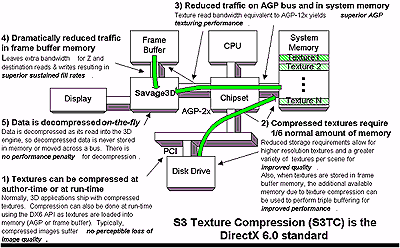Step two to better Texture Quality
So we have these larger textures being stored in system memory after being transferred over the AGP bus, and these textures are put to work using the DIME specification, but where does S3 fit into this all? Instead of relying solely on the benefits of AGP to allow for game developers to toss incredible amounts of textures at the graphics subsystem, S3 realized that although AGP allows for a large portion of your system memory to be used for texture storage and manipulation, there is still a limit to the effectiveness of the technology. Primarily, the amount of system memory available for AGP to make use of. The next logical step in this progression would be to somehow compress the textures to a point that even larger, and higher quality, textures could be stored in the same amount of system memory, therefore giving us step two, to better texture quality: S3's Texture Compression.
S3's 6:1 compression ratio provided for by the S3 Texture Compression (S3TC) technology allows for the seamless integration of compression technology, with no noticeable visual penalty, due to its full support in Microsoft's DirectX 6.0. S3TC isn't something S3 cooked up on the side, it is a fully licensable and readily available compression algorithm that is supported in DirectX 6.0, it's about time a company realized that proprietary isn't the way to go to make your presence known in the market. Just to get a vague idea of the capabilities of S3TC, while the Voodoo2 is limited to texture sizes of 256 x 256 pixels, a S3TC texture is limited to 2048 x 2048 pixel textures.

Copyright 1999 S3
Coupled with full AGP 4X support, to be taken advantage of in Intel's 820 Camino chipset, support for the S3TC standard and improved overall quality are the founding fathers of S3's latest concoction, the Savage4.












0 Comments
View All Comments